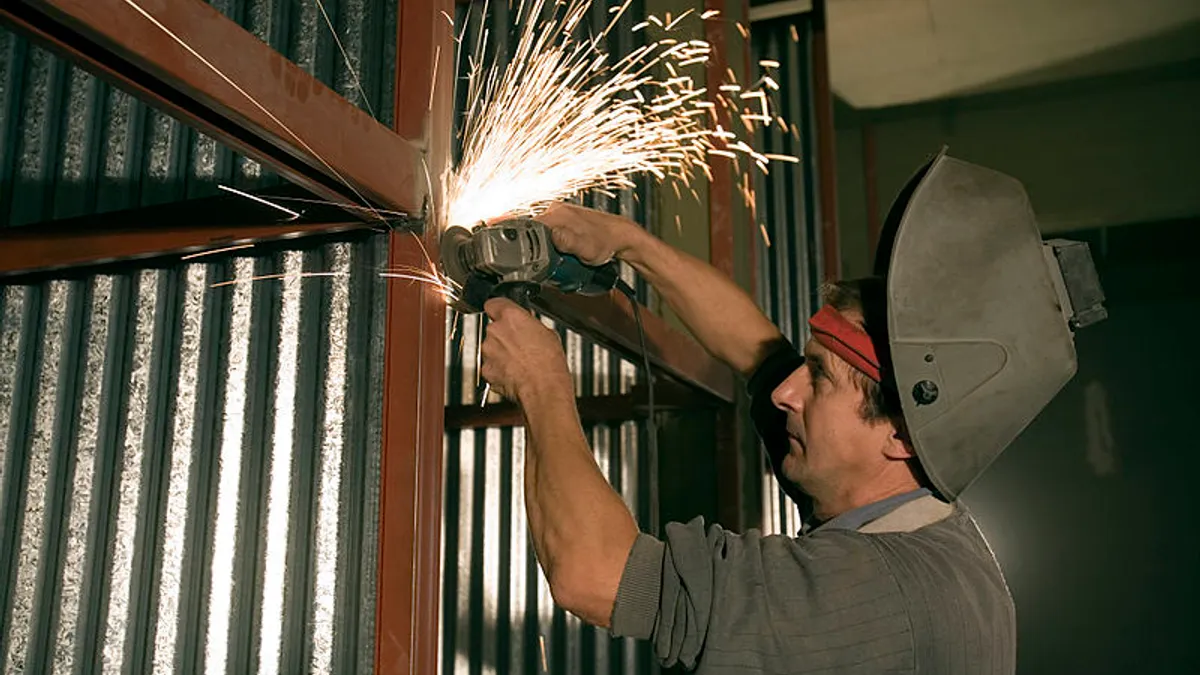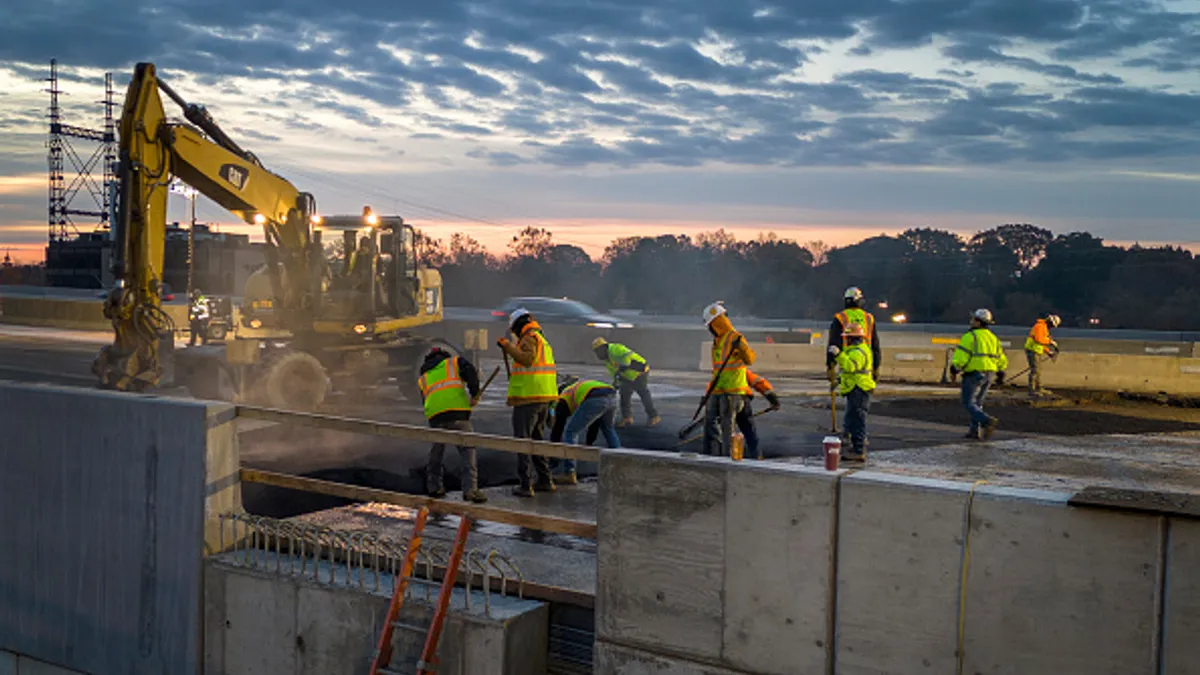Unions were once a bastion of the middle class, but the years have seen a dwindling of union members, particularly in the private sector — including in the construction industry. According to the U.S. Bureau of Labor Statistics, total union membership in 2015 was approximately half what it was in 1983, and the percentage of construction workers who are union members dropped 4% to 13.2% between 2002 and 2015.
Why have unions seen a downturn in recent years? And what factors should construction companies weigh when deciding between union and nonunion labor?
Possible downsides to union labor
Experts point to cost as the primary force behind this shift. The difference between using union versus nonunion labor can mean a 20% cut into a builder's or developer's profits, according to David MacPherson, professor of economics at Trinity University in San Antonio, TX. "I cannot think of a single economic study that has not found that unions lower profits," he told Construction Dive. "So unless union workers are 20% more productive, they’re going to hurt profits."
And, according to Thomas Baylis, partner at Cullen and Dykman LLP in New York — an area that represents one of the last strongholds of trade unions, along with the Midwest and West Coast — the additional cost can be as much as 33%, but typically lands somewhere between 20% to 25%.
"Union work, almost without exception, is more expensive than nonunion," Baylis said. "How expensive depends on the size of the project and the scope of work." Almost all of the megajobs, like the La Guardia airport and One World Trade Center, are still union, according to Baylis, because many fall under prevailing wage laws, which require owners to pay union wages, whether or not they use union labor. And for most public improvement projects, it’s union all the way, Baylis noted.
So why are union wages so expensive? In addition to the base wage, unions typically don’t scrimp on benefits like healthcare and retirement savings, which are also calculated into construction costs. The BLS reported that, on average, construction union members earned $1,099 per week in 2015, whereas their nonunion counterparts made only $743.
Baylis said that union benefit packages can be almost as expensive as the wage rate itself, and McPherson added that union members receive benefits that simply don’t come with a standard construction job anymore. As competition increases, he said, that kind of compensation package may not be sustainable.
Benefits of unions
Why use union labor at all then? The most straightforward reason is that many large public projects, or those receiving significant government subsidies, require the use of either union workers or prevailing wages, like in the cases of the Apple Campus 2 "spaceship" complex in Cupertino, CA, and Tesla’s gigafactory in Reno, NV.
According to Bill Farrell, communications director at the New York City law firm of Pitta Bishop Del Giorno & Giblin LLC, — which represents various trade unions, including the International Union of Operating Engineers Local 14 — another payoff building owners can expect from using union labor is a safe and vastly more productive jobsite due to the extensive training union members receive.
Baylis said some unions even provide training in CAD, software and other tech subjects, in addition to their standard apprenticeship and continuing education programs. "I’ve had contractors say to me, 'I’d rather hire a union guy because a young (worker) coming out of the union is going to know more than someone who has just been working at various jobs (in the industry).'" And on some huge projects with liquidated damages, Baylis said it’s even more critical to get the work right the first time.
"If you’re a builder, you are assured of having a skilled and trained workforce," Farrell said. He referred to the "two-day rule," by which union crews can pour concrete and complete a floor of a high-rise once every two days. "That’s remarkably fast, and it’s done safely and it’s done right."
Baylis said another positive comes from the fact that when a company needs a certain number of skilled workers on a job right away, unions typically have a ready supply. Farrell added that unions also prevent workers from getting cheated out of their wages and ensure that injured workers get the proper care — unlike some of the low-cost competitors who cut corners wherever they can, even at the expense of worker health and safety.
And safety is where Farrell said the union really pays off. He said that, according to a New York Committee for Occupational Safety and Health (NYCOSH) report, 79% of the New York City job site accidents in which a worker fell and died were at nonunion sites. The NYCOSH report also found that 90% of city construction companies in federal OSHA's Severe Violator Enforcement Program are nonunion as well. Union workers take the required OSHA safety courses, and shop stewards oversee work rules, creating a safe and productive work environment, according to Farrell. "It just makes sense when you’re talking about human lives," he said.
MacPherson said there is evidence to suggest that union crews actually have a higher productivity rate because they have lower turnover — which leads to familiarity with how the job runs — but he said that is rarely enough to offset the higher wages.
Are unions facing extinction?
So what does the future hold for trade unions in the U.S.? Baylis said the tradition of familial recruitment for unions — when parents or relatives bringing in younger family members — will be hard to overcome, but introducing new blood is necessary if the organizations are to survive.
Farrell said it depends on the union, but most have open periods for people to apply to join. "Historically, it’s been a who-you-know not what-you-know type of deal, and the unions are working very hard and very aggressively to change that and open their doors and do outreach in the community," Farrell said.
Laws like the Davis-Bacon Act, which requires prevailing wages be paid on federally funded construction projects, will also continue to benefit unions because, according to Baylis, if an owner has to pay higher wages anyway, he’ll often opt for the added value of a trained union workforce.
MacPherson added that Davis-Bacon also eliminates the union problem of being undercut on price because of lower wages. In fact, according to MacPherson, this factor is probably one of the biggest reasons unions have survived as long as they have — at least for government projects.
If unions are to survive, however, it’s possible that wage concessions may play a larger role in their negotiations. For instance, in Boston, trade unions have joined forces to provide apartment construction "packages" at lower wage rates in return for developer and owner promises to use all union labor. The union’s position is that the lower pay is in the interest of affordable housing, but there might be an element of self-preservation in the agreement as well.
Not speaking to the Boston projects specifically, MacPherson said that wage concessions usually enter the picture "when (unions) are facing extinction." Otherwise, he said, if jobs are plentiful, there’s really no motivation to even consider lowering their rate of pay.
Farrell said he is not counting unions out just yet. "My sense is people have seen the middle class slowly being chipped away, and people will begin to vote in their own interests again," he said. "The middle class is falling apart, so I think the light bulb is going to go off at some point and people will start thinking … when the unions were here, we were doing fine."
"That," he added, "is going to be the magic wand."






















